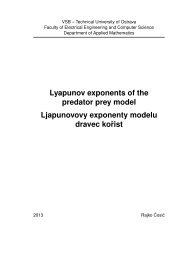The Boundary Element Method for the Helmholtz Equation ... - FEI VÅ B
The Boundary Element Method for the Helmholtz Equation ... - FEI VÅ B
The Boundary Element Method for the Helmholtz Equation ... - FEI VÅ B
Create successful ePaper yourself
Turn your PDF publications into a flip-book with our unique Google optimized e-Paper software.
8540.540.430.430.220.320100.20.110−0.2−10−0.1−1−0.4−2−0.2−2−0.6−3−0.3−3−0.8−4−4−2024024(a) Real part.−2−4−0.4−0.5−4−4−202024 4(b) Imaginary part.−2−4−1Figure 5.11: Scattered wave on <strong>the</strong> sound-hard cube with E = 1200.4413130.52210.51000−10−1−0.5−2−2−3−0.5−3−1−4−4−2024024(a) Real part.−2−4−1−4−4−202024 4(b) Imaginary part.−2−4−1.5Figure 5.12: Total wave on <strong>the</strong> sound-hard cube with E = 1200.5.6 Exterior Mixed <strong>Boundary</strong> Value ProblemFinally, we consider <strong>the</strong> exterior mixed boundary value problem (3.53) with κ = 2, <strong>the</strong>testing solution (5.7) and Ω being <strong>the</strong> sphere and <strong>the</strong> cube. <strong>The</strong> testing domains aredecomposed in <strong>the</strong> same way as in <strong>the</strong> case of <strong>the</strong> interior mixed problem in Section 5.3.We solve <strong>the</strong> problem of finding <strong>the</strong> missing Cauchy data using <strong>the</strong> discretized Galerkinequations corresponding to <strong>the</strong> symmetric approach (3.56), i.e.,a(s h , t h , ψ k , ϕ l ) = F (ψ k , ϕ l )<strong>for</strong> all k ∈ E D , j ∈ N N









